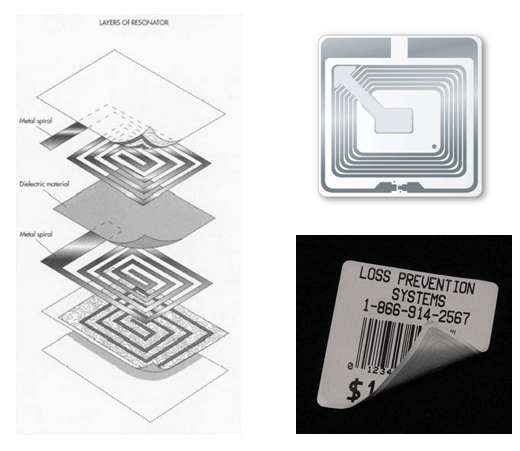Inside each Checkpoint Radio Frequency (RF) label or hard tag is a resonator, a device that picks up the transmitted signal and repeats it. The Checkpoint antennas or gates also contains a receiver that is programmed to recognize whether it is detecting the target signal during the time gaps between the pulses being broadcast by the gates. This signal is generally at 8.2 MHz But it can be anywhere from 8.0 to 9.5 MHz depending on the needs of the retailer.
Sensing a signal during these intervals indicates the presence of a signal being resonated (rebroadcast) by a security label or tag in the detection zone. When this occurs, the Checkpoint System sounds an alarm; in most Checkpoint systems, the alarm sound is accompanied by flashing lights.
This is how a Checkpoint Label is constructed:

Checkpoint hard tags have the same technology in them but are in a hard plastic case. After the resonator is inserted into the hard tag’s plastic casing, the locking mechanism is installed. This usually consists of a clutch that will accept and lock a metal pin that can be inserted through a product at the retail store.
There are numerous designs of clutches, but one example is a metal plate with a small hole in the middle. The hole is too small for the pin’s shaft to pass through unless the metal plate is flexed to enlarge the hole. Once the pin is inserted, the plate flattens, and the minimized hole fits around a grooved section in the shaft of the pin. To release this grip, the sales clerk inserts the tag into a magnetic device that flexes the clutch plate, allowing the pin to slide free.
Another example of a clutch type is a ring of tiny balls that encircle the pin, with a spring mechanism pressing the balls into a groove in the pin’s shaft; a magnetic deactivator retracts the balls from the groove, releasing the pin. Still other tag designs use a mechanical deactivator that inserts a probe into the tag to physically disengage a locking device.
Hard tag clutches come in different strengths: Standard Lock (most common and easiest to defeat), Super Lock and Checkpoint’s S3.
Like labels hard tags come in hundreds of variations and quality. Cheap hard tags are very easy to defeat and offer very little protection. This LPSI video demonstrates this.
Checkpoint Systems hard tags are designed to be used over and over. The tag and pin are removed by staff at checkout. The pin and hard tag are generally placed in separate bins under the cash/wrap and then taken to the back of the store to be used again.
Labels are a one-time use. When merchandise with a label is brought to the checkout the Cashier passes it over a deactivator which is built into the cash/wrap and the label is deactivated or “killed”. The customer leaves the store with the merchandise and the label is discarded with the merchandise packaging. Cheap labels can re-activate prior to the customer leaving and cause an alarm.
